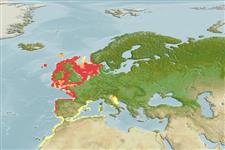>
Gadiformes (Cods) >
Gadidae (Cods and haddocks)
Etymology: Trisopterus: Greek, tris = thrice + Greek, pteron = wing, fin (Ref. 45335).
More on author: Linnaeus.
Environment: milieu / climate zone / depth range / distribution range
Ecologia
marino; salmastro benthopelagico; oceanodromo (Ref. 51243); distribuzione batimetrica 30 - 100 m (Ref. 3663). Temperate; 62°N - 25°N, 19°W - 16°E
Northeastern Atlantic: from Norway to Morocco incl. British Isles and offshore islands, and Skagerrak, and in the western Mediterranean Ref. 1371, 90172).
Length at first maturity / Size / Peso / Age
Maturity: Lm 22.1, range 21 - 25 cm
Max length : 46.0 cm TL maschio/sesso non determinato; (Ref. 7034); common length : 30.0 cm TL maschio/sesso non determinato; (Ref. 1371); Età massima riportata: 4 anni (Ref. 1371)
Spine dorsali (totale): 0; Spine anali 0. Chin barbel well developed. Pelvic fins with slightly elongated anterior rays. Body light brown dorsally, relatively tall, grayish on the sides becoming silvery ventrally, with four or five broad indistinct transverse bars on the sides; a dark blotch at the upper edge of the pectoral-fin base (Ref. 1371). Eye diameter as snout length. Anus lies below the middle of the first dorsal fin (Ref. 35388).
Gregarious fish; immature ones often occur in large schools. Lives mostly on the outer shelf, but moves inshore to depths of 50 m or less for spawning. Feeds on benthic crustaceans but also on small fish, mollusks and polychaetes (Ref. 3663). Caught as a bycatch, used as food fish (Ref. 35388).
Oviparous, sexes are separate (Ref. 205).
Cohen, D.M., T. Inada, T. Iwamoto and N. Scialabba, 1990. FAO species catalogue. Vol. 10. Gadiform fishes of the world (Order Gadiformes). An annotated and illustrated catalogue of cods, hakes, grenadiers and other gadiform fishes known to date. FAO Fish. Synop. 125(10). Rome: FAO. 442 p. (Ref. 1371)
IUCN Red List Status (Ref. 130435)
Threat to humans
Harmless
Human uses
Pesca: commerciale; Acquario: Acquari pubblici
Informazioni ulteriori
BibliografiaAcquacolturaProfilo di acquacolturaVarietàGeneticaElectrophoresesEreditarietàMalattieElaborazioneNutrientsMass conversion
Strumenti
Special reports
Download XML
Fonti Internet
Estimates based on models
Preferred temperature (Ref.
123201): 7.1 - 12.8, mean 9.6 °C (based on 168 cells).
Phylogenetic diversity index (Ref.
82804): PD
50 = 0.5625 [Uniqueness, from 0.5 = low to 2.0 = high].
Bayesian length-weight: a=0.00741 (0.00638 - 0.00861), b=3.10 (3.06 - 3.14), in cm total length, based on LWR estimates for this species (Ref.
93245).
Trophic level (Ref.
69278): 3.7 ±0.1 se; based on diet studies.
Resilienza (Ref.
120179): Medio, tempo minimo di raddoppiamento della popolazione 1.4 - 4.4 anni (K=0.2-0.4; tm=1-2; tmax=4; Fec=200,000).
Prior r = 0.32, 95% CL = 0.21 - 0.48, Based on 1 stock assessment.
Fishing Vulnerability (Ref.
59153): Low to moderate vulnerability (26 of 100).
Climate Vulnerability (Ref.
125649): Low to moderate vulnerability (34 of 100).
Nutrients (Ref.
124155): Calcium = 69.1 [17.6, 230.8] mg/100g; Iron = 0.679 [0.148, 3.039] mg/100g; Protein = 18.8 [16.2, 20.9] %; Omega3 = 0.649 [0.318, 1.346] g/100g; Selenium = 14.4 [6.8, 30.3] μg/100g; VitaminA = 13.5 [3.5, 52.7] μg/100g; Zinc = 1.29 [0.32, 3.68] mg/100g (wet weight); based on
nutrient studies.
